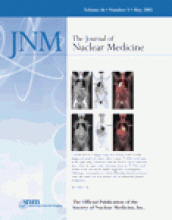TO THE EDITOR:
In a recent article by de Keizer et al. (1), the red marrow dosimetry model that I described in a previous issue of The Journal of Nuclear Medicine (2) was used to estimate red marrow absorbed doses for patients receiving 131I-NaI. The formulation I described was based on the expected distribution of antibodies. It does not apply to the much smaller NaI molecule.
The key difference is in the distribution volume of the 2 radiopharmaceuticals. Radiolabeled antibody is assumed to initially distribute in the plasma and extracellular fluid space of the red marrow, spleen, and liver—organs whose extracellular fluid space rapidly equilibrates with plasma. The total volume of this initial distribution space is 2.5–4 L. Correspondingly, the initial plasma percentage of injected activity per liter (%IA/L) for antibodies is in the range of 25–40 (i.e., the reciprocal of the initial distribution volume). The initial %IA/L for 131I-NaI is in the range of 3–6, giving initial distribution volumes of 30–17 L. This means that the 131I is not confined to the extracellular fluid of the red marrow but is most likely evenly distributed throughout a much larger volume that includes the blood and the red marrow. The concentration of 131I in blood is, therefore, a better direct approximation of the concentration in red marrow. Use of a factor of between 0.2 and 0.4 to convert blood activity concentration to marrow activity concentration will underestimate the red marrow activity concentration (and, therefore, the absorbed dose) by between 5 and 2.5, respectively.







